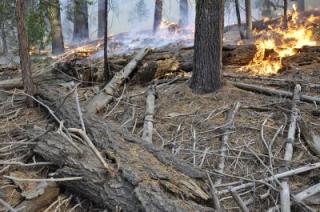Feb 12 2015
Healthy forest ecosystems need dead wood to provide important habitat for birds and mammals, but there can be too much of a good thing when dead wood fuels severe wildfires. A scientist with the U.S. Forest Service's Pacific Southwest Research Station (PSW) compared historic and recent data from a forest in California's central Sierra Nevada region to determine how logging and fire exclusion have changed the amounts and sizes of dead wood over time. Results were recently published in Forest Ecology and Management.
 Forest managers must balance concerns for wildlife habitat with reducing the chance for damaging wildfires. Credit: Photo by U.S. Forest Service
Forest managers must balance concerns for wildlife habitat with reducing the chance for damaging wildfires. Credit: Photo by U.S. Forest Service
PSW Research Ecologist Eric Knapp and a field crew visited three research plots initially established in 1929 in old-growth, mixed conifer stands on the Stanislaus National Forest. The stands had not burned since 1889 and were logged with a variety of methods later in 1929, shortly after the first survey of the plots. In this study, Knapp and a research crew first used digitized maps to locate and re-measure all live and dead trees in the plots. They later used old plot maps to reconstruct the number and size of downed logs in the 1929 plots and also surveyed logs in the present-day plots.
The research crew compared their present-day data with those from 1929 and documented a more than nine-fold increase in the density of standing dead trees (snags) coupled with a decrease in the average diameter of the snags. Additionally, they observed nearly three times as many logs on the ground (coarse woody debris), but found a substantial decrease in the size of these logs. The majority of downed logs in the present-day re-measurement were highly decayed.
"Because larger-sized dead wood is preferred by many wildlife species, the current condition of more, smaller, and more decayed woody pieces may have a lower ratio of habitat value relative to potential fire hazard," says Knapp. Long-term dead wood changes in these forests pose a challenge for forest managers who must balance concerns for wildlife habitat with reducing the chance for damaging wildfires.
But dead trees, like live trees, can be managed. "To restore dead wood to conditions more like those found historically will require growing larger trees and reducing the addition of dead wood from small and intermediate-sized trees," says Knapp. "Forest thinning, through mechanical means and/or fire has been shown to slow the mortality rate of the remaining trees. In addition, using prescribed fire and low-intensity wildfire, which preferentially consume smaller and more decayed wood, would shift the balance to larger and less decayed pieces of dead wood, and help reduce fuels that contribute to uncharacteristically severe wildfires."
To read the paper, view or download the publication from Treesearch, the U.S. Forest Service online system for sharing free, full text publications by Research and Development scientists.
Headquartered in Albany, Calif., the Pacific Southwest Research Station develops and communicates science needed to sustain forest ecosystems and other benefits to society. It has research facilities in California, Hawaii and the U.S.-affiliated Pacific Islands. For more information, visit www.fs.fed.us/psw/.